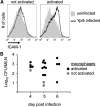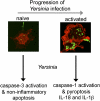Innate immune response during Yersinia infection: critical modulation of cell death mechanisms through phagocyte activation
- PMID: 19734471
- PMCID: PMC2774879
- DOI: 10.1189/jlb.0309146
Innate immune response during Yersinia infection: critical modulation of cell death mechanisms through phagocyte activation
Abstract
Yersinia pestis, the etiological agent of plague, is one of the most deadly pathogens on our planet. This organism shares important attributes with its ancestral progenitor, Yersinia pseudotuberculosis, including a 70-kb virulence plasmid, lymphotropism during growth in the mammalian host, and killing of host macrophages. Infections with both organisms are biphasic, where bacterial replication occurs initially with little inflammation, followed by phagocyte influx, inflammatory cytokine production, and tissue necrosis. During infection, plasmid-encoded attributes facilitate bacterial-induced macrophage death, which results from two distinct processes and corresponds to the inflammatory crescendo observed in vivo: Naïve cells die by apoptosis (noninflammatory), and later in infection, activated macrophages die by pyroptosis (inflammatory). The significance of this redirected cell death for the host is underscored by the importance of phagocyte activation for immunity to Yersinia and the protective role of pyroptosis during host responses to anthrax lethal toxin and infections with Francisella, Legionella, Pseudomonas, and Salmonella. The similarities of Y. pestis and Y. pseudotuberculosis, including conserved, plasmid-encoded functions inducing at least two distinct mechanisms of cell death, indicate that comparative studies are revealing about their critical pathogenic mechanism(s) and host innate immune responses during infection. Validation of this idea and evidence of similar interactions with the host immune system are provided by Y. pseudotuberculosis-priming, cross-protective immunity against Y. pestis. Despite these insights, additional studies indicate much remains to be understood concerning effective host responses against Yersinia, including chromosomally encoded attributes that also contribute to bacterial evasion and modulation of innate and adaptive immune responses.
Figures



Similar articles
-
Yersinia pestis versus Yersinia pseudotuberculosis: effects on host macrophages.Scand J Immunol. 2012 Dec;76(6):541-51. doi: 10.1111/j.1365-3083.2012.02767.x. Scand J Immunol. 2012. PMID: 22882408
-
Inheritance of the lysozyme inhibitor Ivy was an important evolutionary step by Yersinia pestis to avoid the host innate immune response.J Infect Dis. 2013 May 15;207(10):1535-43. doi: 10.1093/infdis/jit057. Epub 2013 Feb 12. J Infect Dis. 2013. PMID: 23402825
-
Immunology of Yersinia pestis Infection.Adv Exp Med Biol. 2016;918:273-292. doi: 10.1007/978-94-024-0890-4_10. Adv Exp Med Biol. 2016. PMID: 27722867 Review.
-
Pentaplex real-time PCR for differential detection of Yersinia pestis and Y. pseudotuberculosis and application for testing fleas collected during plague epizootics.Microbiologyopen. 2020 Oct;9(10):e1105. doi: 10.1002/mbo3.1105. Epub 2020 Aug 12. Microbiologyopen. 2020. PMID: 32783386 Free PMC article.
-
Turning Yersinia pathogenesis outside in: subversion of macrophage function by intracellular yersiniae.Clin Immunol. 2005 Mar;114(3):216-26. doi: 10.1016/j.clim.2004.07.013. Clin Immunol. 2005. PMID: 15721832 Review.
Cited by
-
Cluster analysis of host cytokine responses to biodefense pathogens in a whole blood ex vivo exposure model (WEEM).BMC Microbiol. 2012 May 20;12:79. doi: 10.1186/1471-2180-12-79. BMC Microbiol. 2012. PMID: 22607329 Free PMC article.
-
Transcriptomic and innate immune responses to Yersinia pestis in the lymph node during bubonic plague.Infect Immun. 2010 Dec;78(12):5086-98. doi: 10.1128/IAI.00256-10. Epub 2010 Sep 27. Infect Immun. 2010. PMID: 20876291 Free PMC article.
-
Galectin-1 Cooperates with Yersinia Outer Protein (Yop) P to Thwart Protective Immunity by Repressing Nitric Oxide Production.Biomolecules. 2021 Nov 4;11(11):1636. doi: 10.3390/biom11111636. Biomolecules. 2021. PMID: 34827634 Free PMC article.
-
Acetylcholine and an acetylcholinesterase inhibitor neostigmine can aggravate tularemia progress in BALB/c mice.Interdiscip Toxicol. 2012 Mar;5(1):21-4. doi: 10.2478/v10102-012-0004-7. Interdiscip Toxicol. 2012. PMID: 22783145 Free PMC article.
-
Proteasome inhibitors prevent caspase-1-mediated disease in rodents challenged with anthrax lethal toxin.Am J Pathol. 2010 Aug;177(2):735-43. doi: 10.2353/ajpath.2010.090828. Epub 2010 Jul 1. Am J Pathol. 2010. PMID: 20595632 Free PMC article.
References
-
- Inglesby T V, Dennis D T, Henderson D A, Bartlett J G, Ascher M S, Eitzen E, Fine A D, Friedlander A M, Hauer J, Koerner J F, Layton M, McDade J, Osterholm M T, O'Toole T, Parker G, Perl T M, Russell P K, Schoch-Spana M, Tonat K. Plague as a biological weapon: medical and public health management. Working Group on Civilian Biodefense. JAMA. 2000;283:2281–2290. - PubMed
-
- Koirala J. Plague: disease, management, and recognition of act of terrorism. Infect Dis Clin North Am. 2006;20:273–287. - PubMed
Publication types
MeSH terms
Substances
Grants and funding
LinkOut - more resources
Full Text Sources
Medical

